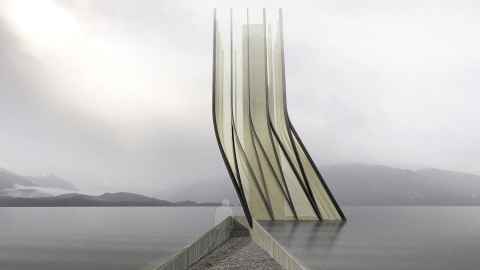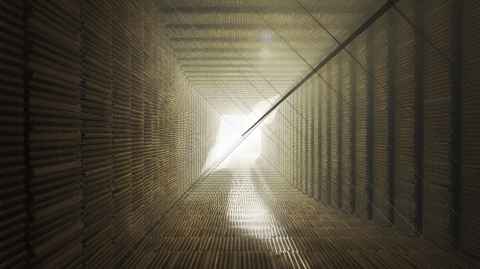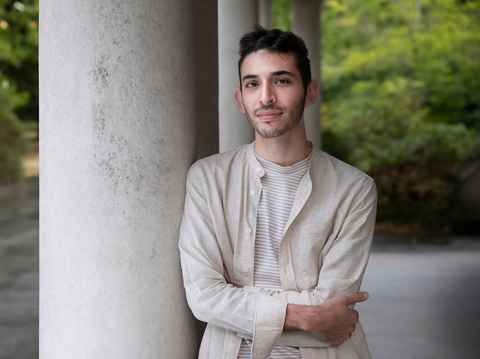Major Blues Award for spirit-moving project
3 October 2020
Abdallah Alayan has won a Major Blues Awards for demonstrating excellence in architecture for his architectural project, ‘Faith in Fiordland’, designed to engage and ignite the spirit.

The Award, for the Most Meritorious Performance (Arts and Culture) is the latest in a number of recognitions that Abdallah, who will graduate with a Master of Architecture in November, has received in the last year.
He was a finalist in the student category of the 2019 Interior Awards for his project ‘Te Papa North’ which was also recognised by the Designers Institute of New Zealand’s Best Design Awards that year with a Gold Pin for spatial excellence
This year, his project ‘Faith in Fiordland’ is a finalist for both the Best and Interior awards once again. Completed for his masters thesis, 'Faith in Fiordland' also won him first equal in the 2019 New Zealand institute of Architects (NZIA) Student Design Awards and now, a University Blues
“To be honest, I was pretty blown away,” says Abdallah, of his latest win. “I know the calibre of the other cultural achievements in the University, in music and the arts for example, so this definitely took me by surprise.”
It is one (wonderful) thing to be recognised by the design and architectural sector, he adds, but to be recognised by the University for a broader cultural contribution is another. “That really took me aback.”
‘Faith in Fiordland’ was designed to progress the architectural conversation around spirituality, but is an unbuilt project, so its success is hard to measure he says. “So it was particularly meaningful that the panel could look beyond traditional measurements of achievement, to look to the intention of a project and its potential positive outcomes in a discourse.”

The NZIA jury said it made a sophisticated and timely case for tolerance and mutual respect “expressed with clarity and sensitivity, premised on inclusivity and inspired with optimism” and that it revealed “a profound understanding of and sympathy for the human condition, our capacity to be awestruck by nature”.
They also noted that Alayan had demonstrated particular personal resilience to complete a high-quality project in the year in which his older brother, Atta, a 33-year-old software developer and goalkeeper for the Futsal Whites indoor football team, was killed while praying at the Al Noor Mosque.
Abdallah says that the terror attack, that cost the lives of 51 Muslim worshippers, encouraged him to explore the potential of architecture to draw attention to and articulate what we have in common rather than what divides us.
In an increasingly secular society, he says, the spirit is not often seen as deserving architectural importance. It should be. “The loss of my brother on that Friday made it clear to me that focusing on what unites us isn’t just necessary, it’s urgent. With that in mind, I made it my task to generate spaces that articulate the many things our bodies and spirits share in common.”
As he said in a Listener article earlier this year, spaces for spiritual engagement are usually designed within the parameters of religious typologies, yet the majority of people he knows aren’t religious. “So, we have all these people, particularly in younger generations, detached from religion, left with no accessible spaces designed to engage their spirits.
“Even if you don’t believe the spirit is a real entity, being spiritually moved is something everyone is capable of, and engaging the spirit has a huge impact on our well-being, whether or not you are religious.”
We might visit religious heritage buildings as tourists overseas, and the spiritual qualities of such buildings can be inclusive as accessible landmarks but “we don’t really have equivalent architectural tourism available for people of all denominations in New Zealand, because of our youth and secularism as a nation.”
“So the project was trying to address that gap by harnessing our most valuable touristic asset, our environment. Fiordland, specifically, is as spiritually moving as a landscape can be, but the project’s architectural interventions recalibrate the touristic gaze and create a relationship between nature and architecture which heightens the spiritual qualities of both.”
Abdallah has returned to live in Christchurch, to take up a full-time role working for IKON Architects, a local practice which he worked for over the past four years, first as an intern, then on a permanent part time basis, before beginning full time work late last year. “I feel extremely fortunate to have started working early as that real-word experience fed my studies at university and made for a smooth transition into work. It’s a privilege to be in practice, especially after the industry closing many of its doors for young people during these uncertain times."
“I’ve been really lucky to be leading a diverse range of projects since I’ve started full time. It’s rare that a recent graduate is given the responsibility and creative agency that IKON gives me, and the experience so far has been hugely rewarding. I’m excited to continue growing my practical skills and hopefully contribute to positive architectural outcomes across the country.”
The Blues Awards are part of a tradition from England. The blue colours of Oxford and Cambridge Universities came to symbolise sporting excellence, but the University of Auckland now acknowledges achievements in Sport as well as Arts and Culture, Service and Leadership and Innovation.

Media contact
Margo White | Media Adviser
Tel 09 923 5504
Mob 021 926 408
Email margo.white@auckland.ac.nz